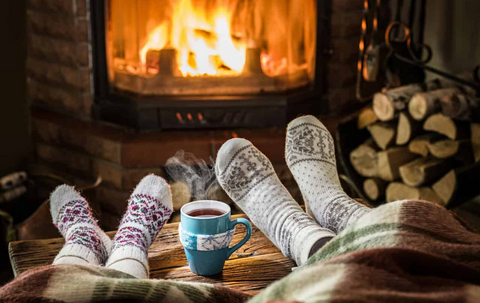Whether winter is your favorite season or your most despised, it pays to be prepared.
From frozen pipes to icy walkways, there’s no shortage of potential dangers to a home (and its residents) during the coldest months.
Below, we look at 9 winter home maintenance tasks to keep you and family safe this season:
Winter Home Maintenance #1: Inspect Faucets & Pipes
Frozen pipes can be a huge pain to deal with, which is why it’s much better to take steps to prevent them from occurring in the first place.
First off, keep your heat on – above 55° F! While this can be expensive during the colder months, it’s a lot cheaper than dealing with a frozen or burst pipe.
Second, make sure that insulation in your home – especially in attics, basements, and crawl spaces – is functioning as it should. Some routine maintenance can help prevent the temperature in these areas from dipping too low and unexposed pipes from freezing.

Lastly, for the pipes you have access to, it’s best to wrap them with insulation (such as lagging, a foam material that insulates and reinforces them, or heat tape). This can help prevent water damage from unheated pipes from freezing and bursting in the winter.
Want extra peace of mind? Place a Notion Sensor near any faucets, pipes, and sinks to get notified about leaks before they become a big problem.
#2: Prep for Winter Storms
Keeping a close eye on the weather and storm activity isn’t just important to keep your family safe, it could also save you from costly property damage.
Winter in some regions of the U.S. can mean blizzards, ice storms, and other severe weather events. By staying informed of these weather developments, you’ll have more time to get prepared and make better decisions.

Equally important is getting your home stocked with the right supplies.
Some items that you should consider buying are batteries, drinking water, emergency medical gear, toilet paper, shovels, flashlights, rock salt, a fire extinguisher, and anything else specific to your business.
If you live in a region with frequent power outages, it’s also a good idea to get a back-up source of heat or electricity.
#3: Prevent Ice Dams
If your attic isn’t well insulated, heat can pass through your roof causing snow to melt. If it’s cold enough outside, it may refreeze as it runs toward the lower roof, creating what’s known as an ice dam.
Ice dams are dangerous for several reasons – they can fall off the roof and injure someone walking by, they can tear down gutters, shingles, and downspouts, and if enough water pools above the dam, it can get underneath the shingles and sheathing and leak into your roof.

The best preventative method is to ensure that your attic and roof area are well insulated. But if one has already developed on your roof, it’s important to act quickly and remove the dam before they cause any damage to your home.
You can do this by using a roof rake to remove 3-4 feet of the ridge of ice from the lower edge of the roof.
#4: Service Your Chimney
Did you know that fireplaces are one of the biggest causes of home fires during the winter months? So don’t forget to get yours inspected and cleaned before you start roasting any chestnuts!

For this, we generally recommend hiring a professional chimney sweep. Depending on when your chimney was last cleaned, they will remove extra ash, clean the hearth, remove debris and soot, and check the structure of the flute.
#5: Protect Patio Furniture
With summer patio season well behind us, packing up your outdoor furniture should be a priority if you haven’t done it already. But before you put anything away, start by giving it a good clean first to prevent rust from forming over the winter months.

Remember also to keep them in a warm, dry space. While the fabric and material used in outdoor cushions and pillows are made to be unfazed by things like rain, they can develop mold if they’re stored in a wet or musty environment. So do your best to keep them as dry as possible!
#6: Prepare Entryways
Dirt, debris, salt, and water are just a few of the things that can make their way into your entryway area during the cool winter months. Whether you have hardwood, luxury vinyl, or tile in your entryway, it’s best to winter-proof your space to keep damage from occurring.

Door mats and other water-trapping products are your first line of defense to protect your entryway floors. But you may also want to add a few more storage options during the winter months, like extra hooks for jackets and a boot drop-off rack.
#7: Reverse Ceiling Fans
Did you know that running your ceiling fans during the cold winter months can help you save on your heating costs?
It has to do with the angle of your fan blades. During the summer, when your fan is spinning counterclockwise, those angled blades help move air down. That’s why you feel a cool breeze when standing directly underneath the fan.

During the winter, however, when you switch the direction of your ceiling fan, cold air gets drawn upward forcing warmer air back down toward you.
#8: Cover Your Air Conditioner
Modern outdoor AC systems are built very well and tested to ensure that they will hold up in extreme circumstances.
But there are still some benefits to covering your outdoor AC unit in the winter – it keeps your air conditioner coils a little cleaner so it may run a little more efficiently and it also helps prevent water from directly resting on your coils and freezing, which may cause damage.

Most hardware stores carry AC covers, which are plenty easy to install, but you can also go the DIY route. A sheet of plywood or waterproof tarp will both do fine. Just be aware that you should only cover the top 6 inches of the AC unit.
#9: Stock Up on Salt and Sand
Whenever there are freezing temperatures and precipitation, there’s a danger for icy surfaces. An easy solution is to stock up on salt and sand for your walkways, driveways, and patio areas.
Salt helps keep water from refreezing by lowering the freezing point of water, while sand provides added traction. All you have to do is apply a thin layer of the mixture across snow or ice, and you’re all set.

And that’s it! For all its challenges, the winter season can be a very fun time. Follow our tips above to keep your home and family safe this year!





